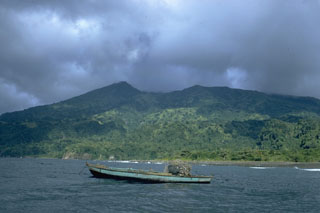Report on Soufriere St. Vincent (Saint Vincent and the Grenadines) — 28 April-4 May 2021
Smithsonian Institution / US Geological Survey
Weekly Volcanic Activity Report, 28 April-4 May 2021
Managing Editor: Sally Sennert.
Please cite this report as:
Global Volcanism Program, 2021. Report on Soufriere St. Vincent (Saint Vincent and the Grenadines) (Sennert, S, ed.). Weekly Volcanic Activity Report, 28 April-4 May 2021. Smithsonian Institution and US Geological Survey.
Soufriere St. Vincent
Saint Vincent and the Grenadines
13.33°N, 61.18°W; summit elev. 1220 m
All times are local (unless otherwise noted)
University of the West Indies Seismic Research Centre (UWI-SRC) reported that seismicity at Soufrière St. Vincent (often simply referred to as “La Soufriere”) remained low during 28 April-4 May, with a few long-period, hybrid, and volcano-tectonic earthquakes recorded daily. Multiple significant lahars were generated by rainfall during 28-29 April. Lahars likely descended all valleys in the Red and Orange zones, and some were hot and visibly steaming. Trees brought down by lahars were swept to the sea; floating logs created hazardous conditions for small boats along the coastline. UWI-SRC and the National Emergency Management Organisation (NEMO) both warned the public to stay away from drainages and areas prone to flooding, and noted that lahars have caused notable erosion and damage to drainages and parts of the coastline. Smaller lahars were recorded during the mornings of 30 April and 1 May. Multiple lahars were detected in likely all the volcano’s drainages for a period of about six hours on 3 May, with the most intense lahars occurring during 1100-1200. Sulfur dioxide emissions were measured from a boat near the W coast, yielding a flux of 1,036 tons per day. Photos showed people in Sandy Bay shoveling off ash from rooftops on 4 May. The volcano Alert Level remained at Red.
Geological Summary. Soufrière St. Vincent is the northernmost and youngest volcano on St. Vincent Island. The NE rim of the 1.6-km wide summit crater is cut by a crater formed in 1812. The crater itself lies on the SW margin of a larger 2.2-km-wide caldera, which is breached widely to the SW as a result of slope failure. Frequent explosive eruptions after about 4,300 years ago produced pyroclastic deposits of the Yellow Tephra Formation, which cover much of the island. The first historical eruption took place in 1718; it and the 1812 eruption produced major explosions. Much of the northern end of the island was devastated by a major eruption in 1902 that coincided with the catastrophic Mont Pelée eruption on Martinique. A lava dome was emplaced in the summit crater in 1971 during a strictly effusive eruption, forming an island within a lake that filled the crater. A series of explosive eruptions in 1979 destroyed the 1971 dome and ejected the lake; a new dome was then built.
Sources: University of the West Indies Seismic Research Centre (UWI-SRC), National Emergency Management Organisation (NEMO), Government of Saint Vincent and the Grenadines

